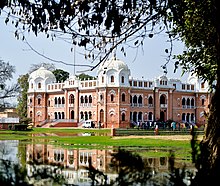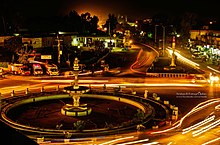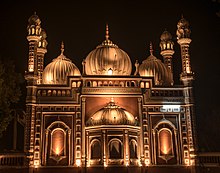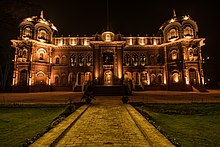Bahawalpur
Bahawalpur
بہاول پور | |
|---|---|
 Clockwise from top:Noor Mahal Palace,Gulzar Mahal,Sadiq Dane High School,Darbar MahalPalace,Sadiq Mosque,Fareed Gate | |
| Nickname: City of Palaces | |
| Coordinates:29°23′44″N71°41′1″E/ 29.39556°N 71.68361°E | |
| Country | |
| Province | Punjab |
| Division | Bahawalpur |
| District | Bahawalpur |
| Union councils | 21 |
| Government | |
| • Type | Metropolitan Corporation |
| • Mayor | None (Vacant)[1] |
| • Commissioner | Ehtisham Anwar[2] |
| Area | |
| •City | 246 km2(95 sq mi) |
| • Metro | 24,830 km2(9,590 sq mi) |
| Elevation | 118 m (387 ft) |
| Population | |
| •City | 762,111 |
| • Density | 3,100/km2(8,000/sq mi) |
| Time zone | UTC+5(PKT) |
| Postal code type | 63100 |
| Area code | 062 |
| Website | Bahawalpur / Punjab Portal |
Bahawalpur(PunjabiandUrdu:بہاول پور,romanised:Bahāwalpūr,pronounced[bəɦɑːʋəlpuːɾ]) is a city inPunjab, Pakistan.It is one of the ten largest cities of Pakistan and6th most populous city of Punjab.[6]Bahawalpur is the capital ofBahawalpur Division.
Founded in 1748, Bahawalpur was the capital of the formerprincely state of Bahawalpur,ruled by the Abbasi family ofNawabsuntil 1955. TheNawabsleft a rich architectural legacy, and Bahawalpur is known for its monuments dating from that period.[7]The city lies at the edge of theCholistan Desert,and serves as the gateway to the nearbyLal Suhanra National Park.
History[edit]
Bahawalpur was among the 584 princely states before thePartition of India.[8]


Early history[edit]
Bahawalpur State was home to various ancient societies. The Bahawalpur region was part of Multan province ofMughal Empirein recent history.[10]It contains ruins from theIndus Valley civilisation,as well as ancient Buddhist sites such as the nearbyPatan minara.[11]British archaeologist SirAlexander Cunninghamidentified the Bahawalpur region as home of theYaudheyakingdoms of theMahābhārata.[12][13]Prior to the establishment of Bahawalpur, Cholistan region's major city wasUch Sharif– a regional metropolitan centre between the 12th and 17th centuries that is renowned for its collection of historic shrines dedicated toMuslim mysticsfrom the 12–15th centuries built in the region's vernacular style.[14]
Establishment[edit]
Bahawalpur was established in 1748 by Nawab Bahawal Khan I,[15]after he migrated to the region aroundUchfromShikarpur,Sindh.[16]Bahawalpur replaced Derawar as the clan's capital city.[17]The city initially flourished as a trading post on trade routes between Afghanistan and central India.[18]
Durrani Attacks[edit]
In 1785, theDurranicommander Sirdar Khan attacked Bahawalpur city and destroyed many of its buildings on behalf of Mian Abdul NabiKalhoraof Sindh.[19]Bahawalpur's ruling family, along with nobles from nearbyUch,were forced to take refuge in theDerawar Fort,where they successfully repulsed further attacks.[19]The attacking Durrani force accepted 60,000 rupees asnazranaor tribute, though Bahawal Khan later had to seek refuge in theRajputstates as the Afghan Durranis occupied Derawar Fort.[19]Bahawal Khan returned to conquer the fort by way of Uch, and re-established control of Bahawalpur.[19]
Princely state[edit]



Theprincely stateof Bahawalpur was founded in 1802 by Nawab Mohammad Bahawal Khan II after the break-up of theDurrani Empire,and was based in the city.
Sikh Attacks and treaties with the British[edit]
In 1807,Ranjit Singhof theSikh Empirelaid siege to the fort inMultan,prompting refugees to seek safety in Bahawalpur in the wake of his marauding forces that began to attack the countryside around Multan.[19]Ranjit Singh eventually withdrew the siege, and gave the Nawab of Bahawalpur some gifts as the Sikh forces retreated.[19]

Bahalwapur offered an outpost of stability in the wake of crumbling Mughal rule and the declining power ofKhorasan'smonarchy.[19]The city became a refuge for prominent families from affected regions and also saw an influx of religious scholars escaping the consolidation of Sikh power in Punjab.[19]
Fearing an invasion from the Sikh Empire,[20]Nawab Mohammad Bahawal Khan III signed a treaty with theBritishon 22 February 1833, guaranteeing the independence of theNawaband the autonomy of Bahawalpur as a princely state. The treaty guaranteed the British a friendly southern frontier during their invasion of the Sikh Empire.[20]
Trade Routes[edit]
Trade routes had shifted away from Bahawalpur by the 1830s, and British visitors to the city noted several empty shops in the city's bazaar.[18]The population at this time was estimated to be 20,000,[18]and was noted to be made up primarily of Hindus.[18]Also in 1833, theSutlejandIndus Riverswere opened to navigation, allowing goods to reach Bahawalpur.[19]By 1845, newly opened trade routes toDelhire-established Bahawalpur as a commercial centre.[19]The city was known in the late 19th century as a centre for the production ofsilkgoods,lungis,andcottongoods.[21]The city's silk was noted to be of higher quality than silk works fromBenaresorAmritsar.[18]
Increased British Influence[edit]
An 1866 crisis over succession to the Bahawalpur throne markedly increased British influence in the princely state.[22]Bahawalpur was constituted as a municipality in 1874.[23]Bahalwapur's Nawab celebrated theGolden JubilleeofQueen Victoriain 1887 in a state function at the Noor Mahal palace.[21]In 1901, the population of the city was 18,546.[17]
The Second World War[edit]
At the outbreak ofWorld War IIin 1939, Bahawalpur's Nawab was the first ruler of a princely state to offer his full support and resources of the state towards thecrown'swar efforts.[24]
Joining Pakistan[edit]
British Princely states were given the option to join either Pakistan orIndiauponBritish withdrawal from the Sub-Continentin August 1947. The city and the princely state of Bahawalpur acceded to Pakistan on 7 October 1947, under NawabSadiq Muhammad Khan Abbasi V Bahadur.[25]Following independence, the city's minorityHinduandSikhcommunitiesmigratedto Indiaen masse,whileMuslimrefugees from India settled in the city and the surrounding region.
Modern[edit]
Muhammad Zia-ul-Haq,the sixthpresident of Pakistan,died in an aircraft crash on 17 August 1988 in Bahawalpur near the Sutlej River after departing from theBahawalpur Airport.Zia's close assistantAkhtar Abdur Rehman,American diplomatArnold Lewis Rapheland 27 others also died in the crash.[26]
District statistics[edit]
There are 6 tehsils in District Bahawalpur, with 109union councils,714 villages, and 5municipal committees.
Climate[edit]
Bahawalpur lies some 117 metres or 384 feet above sea level. The climate is dry; according to theKöppen-Geigersystem, it is classified assemi arid(BSh). The rainfall is around 289 millimetres or 11.4 inches per year.[27]The average annual temperature is 25.7 °C or 78.3 °F.
Flora and Fauna[edit]
Flora[edit]
- Kikar
- Shisham
- Sufaida
- Neem
- Siris
- Toot
- Sohanjana
Fauna[edit]
Economy[edit]


The main crops for which Bahawalpur is recognised arecotton,sugarcane,wheat,sunflower seeds,rape/mustard seedandrice.Bahawalpurmangoes,citrus,datesandguavasare some of the fruits exported out of the country. Vegetables includeonions,tomatoes,cauliflower,potatoesandcarrots.Being an expanding industrial city, the government has revolutionised and liberalised various markets allowing the caustic soda, cotton ginning and pressing, flour mills, fruit juices, general engineering, iron and steel re-rolling mills, looms, oil mills, poultry feed, sugar, textile spinning, textile weaving, vegetable ghee and cooking oil industries to flourish.[28]Sheep and cattle are raised for export of wool and hides.
Crafts[edit]
Bahawalpur is famous for its carpets, embroidery, and pottery. The Punjab government has set up a Craft Development Centre from where handicrafts can be purchased. These handicrafts are mostly manufactured in the Cholistan area.[29]Following is the list of some of the mementos manufactured in the city:
- Flassi:It is made up of camel hair and can be used as a carpet or wall hanging
- Gindi:A colourful combination of cotton cloth with delicate needlework. It can be used as a blanket, carpet, or bed cover
- Changaries:Made up of palm leaves. They can be used as a decorative wall hanging or can be used to store chapatis / wheat bread
- Khalti:A kind of purse with multi-coloured threadwork
- Artwork:Special traditional embroidery done on kurta, chaddar/shawl etc.
Demographics[edit]
According to the2017 Census of Pakistan,the city's population was recorded as having risen to 762,111 from 408,395 in 1998.[6]
| Year | Pop. | ±% |
|---|---|---|
| 1941 | 40,000 | — |
| 1951 | 42,000 | +5.0% |
| 1961 | 84,000 | +100.0% |
| 1972 | 134,000 | +59.5% |
| 1981 | 180,000 | +34.3% |
| 1998 | 408,395 | +126.9% |
| 2017 | 762,111 | +86.6% |
Religion[edit]

Bahawalpur emerged as a centre ofChishtiSufism following the establishment of akhanqaby Noor Muhammad Muharvi in the mid-18th century.[30]Most residents are Muslims with a small minority beingHindusandChristians.There are about 2000 Christian families with one church,St. Dominic's Churchbuilt in 1962 by theGovernment of Punjab(the Dominican Convent School for girls and St. Dominican's Middle School for Boys were also built under the same project). Father Zafar Iqbal was the firstParish priestof the church until his death on 19 February 2009.[31]
| Religious group |
1881[33][34]: 520 [35]: 250 | 1891[36]: 68 [37] | 1901[38]: 44 [39]: 26 | 1911[40]: 23 [41]: 19 | 1921[42]: 25 [43]: 21 | 1931[44]: 26 | 1941[32]: 32 | 2017[45] | ||||||||
|---|---|---|---|---|---|---|---|---|---|---|---|---|---|---|---|---|
| Pop. | % | Pop. | % | Pop. | % | Pop. | % | Pop. | % | Pop. | % | Pop. | % | Pop. | % | |
| Islam |
7,459 | 54.7% | 11,109 | 59.36% | 11,161 | 60.18% | 11,395 | 61.88% | 12,042 | 65.11% | 13,735 | 65.58% | 28,946 | 72.34% | 776,135 | 98.24% |
| Hinduism |
6,082 | 44.61% | 7,450 | 39.81% | 7,236 | 39.02% | 6,879 | 37.36% | 6,363 | 34.41% | 7,166[b] | 34.22% | 10,836[b] | 27.08% | 2,018 | 0.26% |
| Jainism |
48 | 0.35% | 0 | 0% | 0 | 0% | 0 | 0% | 0 | 0% | 0 | 0% | 0 | 0% | — | — |
| Sikhism |
43 | 0.32% | 147 | 0.79% | 135 | 0.73% | 126 | 0.68% | 75 | 0.41% | 29 | 0.14% | 208 | 0.52% | — | — |
| Christianity |
— | — | 10 | 0.05% | 14 | 0.08% | 14 | 0.08% | 14 | 0.08% | 12 | 0.06% | 25 | 0.06% | 11,615 | 1.47% |
| Zoroastrianism |
— | — | 0 | 0% | 0 | 0% | 0 | 0% | 0 | 0% | 1 | 0% | — | — | — | — |
| Ahmadiyya |
— | — | — | — | — | — | — | — | — | — | — | — | — | — | 265 | 0.03% |
| Others | 3 | 0.02% | 0 | 0% | 0 | 0% | 0 | 0% | 0 | 0% | 0 | 0% | 0 | 0% | 31 | 0% |
| Total population | 13,635 | 100% | 18,716 | 100% | 18,546 | 100% | 18,414 | 100% | 18,494 | 100% | 20,943 | 100% | 40,015 | 100% | 790,064 | 100% |
Civic administration[edit]
Bahawalpur was announced as one of six cities in Punjab whose security would be improved by thePunjab Safe Cities Authority.5.6 billion Rupees were allocated for the project,[46]for the city to be modeled along the lines of the Lahore Safe City project in which 8,000CCTVcameras were installed throughout the city at a cost of 12 billion rupees to record and send images to the Integrated Command and Control Centres.[47]
Infrastructure[edit]

- The city'sNoor Mahalpalace was completed in 1875.[17]
- In 1878, the 4,285-foot (1,306 m) long Empress Bridge was constructed as the first rail crossing over the Sutlej River.[17]
- Two hospitals were established in the city in 1898.[17]
- TheBahawal Stadiumor (formerly) The Bahawalpur Dring Stadium.
- TheDarbar Mahalwas built in 1905.
- TheGulzar Mahal
Bahawalpur Museum[edit]
TheBahawalpur Museum,established in 1976, is a museum of archaeology, art, heritage, modern history, and religion. It comes under the control of the Bahawalpur district government.[48]The current director of the museum is Hussain Ahmed Madni. It has eight galleries:
- Pakistan Movementgallery
- Archaeological gallery
- Islamic gallery; manuscripts, inscriptions, andQuranicdocuments
- Cultural heritage gallery
- Art gallery
- Coins gallery
- Cholistangallery
- Nawab Bahawal Memorial gallery
Bahawalpur Zoo[edit]
TheBahawalpur Zoo,established in 1942, is a 25-acre (10 ha) zoological garden. It is managed by the Government of Pakistan.[49]
The zoo has occasionally bred and supplied wild cats, such as Asiatic lions and Bengal tigers, to other zoos in the country. It also has an aquarium and zoological museum with stuffed birds, reptiles, and mammals. The Bahawalpur Zoo is the fourth biggest zoo in Pakistan, afterLahore Zoo,Karachi ZooandIslamabad Zoo.
Railway Station[edit]
- Bahawalpur Railway Stationis located in Bahawalpur city at an elevation of 117 metres. It is one of the major railway stations of Pakistan Railways on the Karachi-Peshawar main line.
- The station is staffed and has advance and current reservation offices.
- In 2016, the Railways MinisterKhawaja Saad Rafiqueannounced that PKR. 280 million will be spent on the construction of a Model Railway Station in Bahawalpur.
- The routes linked Bahawalpur to the cities ofKarachi,Lahore,Rawalpindi,Peshawar,Quetta,Multan,Faisalabad,Sargodha,Sialkot,Gujranwala,Hyderabad,Sukkur,Jhang,Rahim Yar Khan,Nawabshah,Attock,Sibi,Khanewal,Gujrat,Rohri,Jacobabad,andNowshera.
Lal Suhanra National Park[edit]
Lal Suhanrais a national park in Pakistan. The park itself is situated some 35 kilometres east of Bahawalpur. It is one of South Asia's largest national parks and is a UNESCO declared Biosphere Reserve. Lal Sohanra is notable for the diversity of its landscape, which includes desert, forest, and wetland ecosystems.[50]
Education[edit]

Bahawalpur'sSadiq Egerton Collegewas founded in 1886.[17]The first university,Islamia Universitywas founded asJamia Abbasiain 1925. The city'sQuaid-e-Azam Medical Collegewas founded in 1971. The District has an overall literacy rate of 48% with a total of 1662 schools and 24 colleges.[51]
Transportation[edit]
Local transportation vehicles include buses, cars, motorbikes, and rickshaws.
N-5[edit]
Pakistan's longest national highway,N-5,also passes through the city, connecting Bahawalpur toKarachiandLahore.[52]
Railroad[edit]
The railway connects Bahawalpur with the cities of Karachi, Lahore, Rawalpindi, Peshawar, Quetta, Multan, Faisalabad, Sargodha, Sialkot, Gujranwala, Hyderabad, Sukkur, Jhang, Rahim Yar Khan, Nawabshah, Attock, Sibi, Khanewal, Gujrat, Rohri, Jacobabad, and Nowshera.[52]
Sports[edit]
Bahawal Stadiumor (formerly) The Bahawalpur Dring Stadium is a multi-purpose stadium in the city. It hosted a sole international match, atest matchbetween Pakistan and India on 15 and 18 January 1955.[53]Motiullahhockey stadium is in theBahawal Stadiumand is used for various national and international hockey tournaments in the country. Aside from the cricket ground, it has a gym and a pool facility for citizens. There are also tennis courts, under the administration of the Bahawalpur Tennis Club, and a 2-kilometre jogging track around the football ground.
Notable people[edit]
- Film and television actorEhtisham khan,was born in the city
- Former field hockey player,Samiullah Khan,was born in the city[54]
- Former journalist, presenter and producer at theBBC World Service,Durdana Ansari,OBE,was born in the city
- Pakistani footballer,Muhammad Adil
- Former Member ofNational AssemblyNawab Salahuddin Abbasi
- Member of theProvincial Assemblyof Punjab,Samiullah Chaudhary
- Former member of theNational Assembly of PakistanCh.Tariq Bashir Cheema]]
- Disabled Cricket Team Player, Muhammad Zubair Saleem
- Television and theater actor and writer,Saqib Sameer
- Member of National Assembly of Pakistan,Muhammad Farooq Azam Malik
- Mastana – Murtaza Hassan,Pakistani comedian and stage actor
- Usman Tariq,a first-class Pakistani cricketer
See also[edit]
- Bahawalpur Museum
- Bahawalpur Zoo
- List of educational institutions in Bahawalpur
- List of people from Bahawalpur
Notes[edit]
- ^1891-1941: Data for the entirety of the town of Bahawalpur, which included Bahawalpur Municipality.[32]: 32
2017: Combined urban populations of Bahawalpur City Tehsil and Bahawalpur Saddar Tehsil. - ^ab1931-1941: IncludingAd-Dharmis
References[edit]
- ^"Administrators' appointments planned as Punjab LG system dissolves today".The Nation (newspaper).31 December 2021.Retrieved6 January2022.
- ^"Four injured as false ceiling in church building collapses".Dawn (newspaper).26 December 2023.Retrieved30 December2023.
- ^"MC Bahawalpur".MC Bahawalpur. Archived fromthe originalon 26 April 2018.Retrieved25 April2018.
- ^"Pakistan: Tehsils and Talukas (Districts and Subdistricts) – Population Statistics, Charts and Map".
- ^"DISTRICT AND TEHSIL LEVEL POPULATION SUMMARY WITH REGION BREAKUP: PUNJAB"(PDF).Pakistan Bureau of Statistics.3 January 2018. Archived fromthe original(PDF)on 25 April 2018.Retrieved24 April2018.
- ^ab"Pakistan: Provinces and Major Cities – Population Statistics, Maps, Charts, Weather and Web Information".
- ^Dar, Shujaat Zamir (2007).Sights in the Sands of Cholistan: Bahawalpur's History and Architecture.Oxford University Press.ISBN9780195473537.
- ^Copland, Ian (1991)."The Princely States, the Muslim League, and the Partition of India in 1947".The International History Review.13(1): 38–69.doi:10.1080/07075332.1991.9640572.ISSN0707-5332.JSTOR40106322.
- ^"A century later, Bahawalpur's Darbar Mahal stands tall – The Express Tribune".21 April 2017.
- ^Dasti, Humaira Faiz (1998).Multan, a Province of the Mughal Empire, 1525-1751.Royal Book.ISBN978-969-407-226-5.
- ^Auj, Nūruzzamān (1987).Ancient Bahawalpur.Caravan Book Centre.
- ^Gupta, Parmanand (1989).Geography from Ancient Indian Coins & Seals.Concept Publishing Company.ISBN9788170222484.
- ^North Indian Inscriptions volume III: Inscriptions of the Early Gupta Kings.p. 23.
- ^"UNESCO Office in Bangkok: Uch Monument".unescobkk.org.Archived fromthe originalon 23 January 2018.Retrieved26 January2018.
- ^Wright, Arnold, ed. (1922).Indian States: A Biographical, Historical, and Administrative Survey.Asian Educational Services. p. 145.ISBN9788120619654.
- ^Gilmartin, David (5 June 2015).Blood and Water: The Indus River Basin in Modern History.University of California Press.p. 22.ISBN9780520285293.
- ^abcdefCotton, James Sutherland; Burn, Sir Richard; Meyer, Sir William Stevenson (1908).Imperial Gazetteer of India...Clarendon Press.
- ^abcdeThe Asiatic Journal and Monthly Register for British India and Its Dependencies.Black, Parbury, & Allen. 1838.
- ^abcdefghijÁlī, Shahāmat (1848).The History of Bahawalpur: With Notices of the Adjacent Countries of Sindh, Afghanistan, Multan, and the West of India.James Madden.
- ^abBurki, Shahid Javed (19 March 2015).Historical Dictionary of Pakistan.Rowman & Littlefield.ISBN9781442241480.
- ^abbahādur.), Muḥammad Laṭīf (Saiyid, khān (1891).History of the Panjáb from the Remotest Antiquity to the Present Time.Calcutta Central Press Company, limited.
{{cite book}}:CS1 maint: multiple names: authors list (link) - ^Minahan, James (2012).Ethnic Groups of South Asia and the Pacific: An Encyclopedia.ABC-CLIO.ISBN9781598846591.
- ^"Bahawalpur | Pakistan".Encyclopædia Britannica.Retrieved26 January2018.
- ^Javaid, Umbreen (2004).Politics of Bahawalpur: From State to Region, 1947–2000.Classic.
- ^"Our History | Bahawalpur".bahawalpur.punjab.gov.pk.Retrieved17 November2021.
- ^Ali, Naziha Syed (17 August 2018)."Dawn investigations: Mystery still surrounds Gen Zia's death, 30 years on".DAWN.COM.Retrieved6 June2024.
- ^"Climate | Bahawalpur".bahawalpur.punjab.gov.pk.Retrieved17 November2021.
- ^"Punjab Portal".Archived fromthe originalon 3 September 2010.Retrieved17 September2009.
- ^"The People | Bahawalpur".bahawalpur.punjab.gov.pk.Retrieved17 November2021.
- ^Jones, Justin; Qasmi, Ali Usman (13 April 2015).The Shi'a in Modern South Asia: Religion, History and Politics.Cambridge University Press.ISBN9781316338872.
- ^"St. Dominic's Church | Bahawalpur".bahawalpur.punjab.gov.pk.Retrieved17 November2021.
- ^ab"CENSUS OF INDIA, 1941 VOLUME VI PUNJAB".Retrieved9 January2024.
- ^"Census of India, 1881 Report on the Census of the Panjáb Taken on the 17th of February 1881, vol. I."1881.JSTORsaoa.crl.25057656.Retrieved14 January2024.
- ^"Census of India, 1881 Report on the Census of the Panjáb Taken on the 17th of February 1881, vol. II".1881.JSTORsaoa.crl.25057657.Retrieved14 January2024.
- ^"Census of India, 1881 Report on the Census of the Panjáb Taken on the 17th of February 1881, vol. III".1881.JSTORsaoa.crl.25057658.Retrieved20 January2024.
- ^"Census of India, 1891. General tables for British provinces and feudatory states".1891.JSTORsaoa.crl.25318666.Retrieved9 January2024.
- ^"The Punjab and its feudatories, part II--Imperial Tables and Supplementary Returns for the British Territory".1891.JSTORsaoa.crl.25318669.Retrieved9 January2024.
- ^"Census of India 1901. Vol. 1A, India. Pt. 2, Tables".1901.JSTORsaoa.crl.25352838.Retrieved9 January2024.
- ^"Census of India 1901. [Vol. 17A]. Imperial tables, I-VIII, X-XV, XVII and XVIII for the Punjab, with the native states under the political control of the Punjab Government, and for the North-west Frontier Province".1901.JSTORsaoa.crl.25363739.Retrieved9 January2024.
- ^"Census of India, 1911. Vol. 1., Pt. 2, Tables".1911.JSTORsaoa.crl.25393779.Retrieved9 January2024.
- ^"Census of India 1911. Vol. 14, Punjab. Pt. 2, Tables".1911.JSTORsaoa.crl.25393788.Retrieved9 January2024.
- ^"Census of India 1921. Vol. 1, India. Pt. 2, Tables".1921.JSTORsaoa.crl.25394121.Retrieved9 January2024.
- ^"Census of India 1921. Vol. 15, Punjab and Delhi. Pt. 2, Tables".1921.JSTORsaoa.crl.25430165.Retrieved9 January2024.
- ^"CENSUS OF INDIA, 1931 VOLUME XVII PUNJAB PART II TABLES".Retrieved9 January2024.
- ^"Final Results (Census-2017)".Retrieved27 January2023.
- ^"After Lahore, six others to become 'safer cities'".Express Tribune. 20 February 2017.Retrieved23 February2017.
- ^"Punjab Safe City Project inaugurated".Dawn. 12 October 2016.Retrieved23 February2017.
- ^"Bahawalpur Museum | Bahawalpur".bahawalpur.punjab.gov.pk.Retrieved17 November2021.
- ^"Bahawalpur Zoo | Bahawalpur".bahawalpur.punjab.gov.pk.Retrieved17 November2021.
- ^"Lal Suhanra National Park | Bahawalpur".bahawalpur.punjab.gov.pk.Retrieved17 November2021.
- ^"District Profile | Bahawalpur".bahawalpur.punjab.gov.pk.Retrieved17 November2021.
- ^ab"Transportation | Bahawalpur".bahawalpur.punjab.gov.pk.Retrieved17 November2021.
- ^"Bahawal Stadium | Pakistan | Cricket Grounds | ESPNcricinfo".ESPNcricinfo.Retrieved17 November2021.
- ^"Samiullah Khan".PrideOfPakistan. 6 September 1951.Retrieved23 August2022.
Bibliography[edit]
- Moj, Muhammad (2015),The Deoband Madrassah Movement: Countercultural Trends and Tendencies,Anthem Press,ISBN978-1-78308-389-3
- Talbot, Ian (2015),"Introduction",in Roger D. Long; Gurharpal Singh; Yunas Samad; Ian Talbot (eds.),State and Nation-Building in Pakistan: Beyond Islam and Security,Routledge, pp. 1–,ISBN978-1-317-44820-4
- Zahab, Mariam Abou;Roy, Olivier(2004) [first published in French in 2002].Islamist Networks: The Afghan-Pakistan Connection.Translated by King, John. C. Hurst & Co. Publishers.ISBN978-1-85065-704-0.
External links[edit]
 Bahawalpurtravel guide from Wikivoyage
Bahawalpurtravel guide from Wikivoyage- BahawalpuratCurlie



